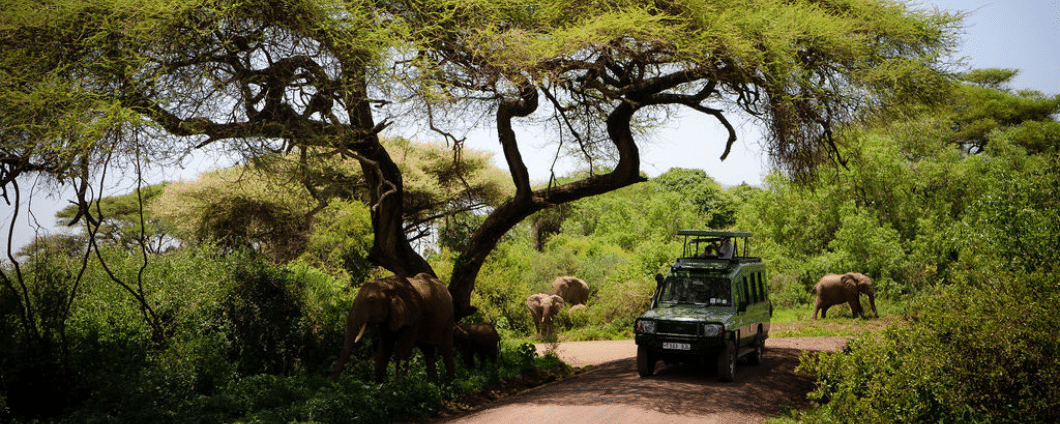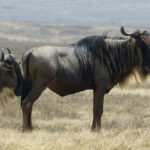Picture yourself standing amidst 1.5 million wildebeests thundering across the plains of Serengeti, a sight so awe-inspiring that it has earned its place among the Seven Natural Wonders of the World. This mesmerizing spectacle, known as the Great Migration, is just one of the many reasons why Serengeti National Park is considered Tanzania’s crown jewel. It’s an unparalleled experience in the natural world, offering a glimpse into the raw and untamed wilderness.
Established in 1951, Serengeti National Park is one of the oldest and most celebrated ecosystems on the planet. Spanning over 14,750 square kilometers, it’s home to the Big Five and a plethora of other wildlife species. With over 500 bird species and the iconic Acacia savannas, the park also plays a crucial role in global biodiversity conservation.

Serengeti National Park: The Crown Jewel of Tanzania
Located in northern Tanzania, Serengeti National Park spans 14,750 square kilometers. It’s famous for its annual Great Migration, where millions of wildebeests, zebras, and gazelles migrate. This event is one of the most spectacular wildlife shows on Earth. The park also features diverse landscapes, from vast grasslands to lush forests. These varied habitats support a rich array of animal species.
The park’s climate varies with altitude, making it a year-round destination. During the dry season, animals gather around water sources, ideal for wildlife viewing. The wet season transforms the park into a green paradise. Bird enthusiasts will find the wet season fascinating, as migratory birds arrive in large numbers. This variety of climates and seasons ensures a unique experience every visit.
The Serengeti is also a key player in global conservation efforts. The park is home to the Big Five: lions, elephants, buffaloes, leopards, and rhinoceroses. Conservation projects help protect these majestic animals from poaching and habitat loss. There are also efforts to involve local communities in conservation activities. This creates job opportunities and raises awareness about the importance of protecting wildlife.
Visiting Serengeti National Park offers more than just a safari experience. Cultural tours introduce visitors to the Maasai people, one of Africa’s most iconic tribes. Tourists can enjoy engaging activities such as traditional dances, storytelling, and craft-making sessions. The park offers various comfortable accommodations, from luxury lodges to mobile camps. This ensures a memorable stay amidst the wilderness while learning about Tanzania’s rich culture.
Overview of the Park’s Biodiversity and Landscape
The Serengeti hosts an incredible variety of life, creating a vibrant ecosystem. It includes over 70 large mammals and approximately 500 bird species. This diversity is spread across different environments such as savannahs, woodlands, and riverine forests. These habitats provide shelter and food for numerous creatures. Each area offers unique opportunities for wildlife observation.
One remarkable feature of the Serengeti’s landscape is its vast open plains. These grasslands are the stage for the Great Migration. Other key landscape elements are the granite kopjes, or rocky outcrops, dotting the terrain. They serve as lookout points for predators like lions and leopards. Rivers and wetlands crisscross the park, supporting lush vegetation and aquatic life.
The biodiversity extends to plant species, with over 4,000 types of vegetation. Acacia trees dominate the savannah, providing shade and food. Grass species vary from short grasses in the southern plains to taller ones in the north. This rich plant life supports the herbivores, which in turn sustain the carnivores. It’s a balanced and interconnected ecosystem.
Conservation is central to maintaining the park’s biodiversity and landscape. Organizations work to preserve habitats and species through various initiatives. Anti-poaching efforts are critical to protecting wildlife. Sustainable tourism practices also aim to minimize environmental impact. Together, these efforts ensure that Serengeti remains a natural wonder for future generations.
Iconic Wildlife and Conservation Efforts
Serengeti National Park is synonymous with iconic wildlife. The park is renowned for its population of lions, often seen lounging on rocks or hunting in prides. Elephants also roam the park freely, their size and presence awe-inspiring. Besides these, the park houses elusive leopards resting in trees. Each of these magnificent animals is integral to the park’s ecosystem.
Conservation efforts are crucial to preserving Serengeti’s rich biodiversity. Anti-poaching initiatives are at the forefront of these efforts. Rangers patrol vast areas daily to protect animals from illegal hunting. Advanced technologies like GPS tracking also help monitor wildlife. These strategies significantly reduce the threats to endangered species.
Community involvement is vital for successful conservation. Local communities participate in programs that promote sustainable living. By offering eco-friendly alternatives, the park ensures that villagers do not rely on poaching for income. Educational campaigns teach the importance of wildlife conservation. This collaboration fosters a sense of shared responsibility.
Research plays a substantial role in guiding conservation strategies. Scientists study animal behaviors, migration patterns, and genetics. Their findings inform policies and protective measures. Such research is pivotal in adapting to changing environmental conditions. It helps maintain the delicate balance within the Serengeti ecosystem.
Cultural Significance and Tourist Experiences
The Serengeti holds deep cultural significance for the Maasai people. They have lived in this region for centuries, their traditions tightly interwoven with the land. The Maasai are known for their distinctive red clothing and beadwork. Visitors can experience their culture through village tours. These tours offer insights into their daily lives and unique customs.
Tourists have a variety of experiences to choose from in the Serengeti. Safari drives are among the most popular activities. Guided tours take visitors close to the wildlife, offering breathtaking views. Hot air balloon rides provide a unique perspective of the park. Floating above the plains, tourists can witness the vast landscape from the sky.
Walking safaris offer a different kind of adventure. These guided walks allow tourists to explore the park on foot. It’s a chance to learn about the flora and smaller creatures often missed in vehicles. Guides share knowledge about animal tracks and plants. This intimate experience brings visitors closer to nature.
Accommodations in the Serengeti range from luxury lodges to mobile camps. Luxury lodges offer comfort and stunning views of the park. Mobile camps provide a more rustic experience, bringing guests closer to nature. Many lodgings include amenities like pools and dining areas. This variety ensures that all types of travelers can find suitable accommodation.
Eco-tourism is a growing trend in the Serengeti. Many tour operators focus on sustainable practices. They aim to minimize environmental impact while supporting local communities. Tourists are encouraged to travel responsibly. This approach ensures that the park remains pristine for future generations.
Special events and festivals highlight the cultural significance of the region. The Great Migration is a natural event not to be missed. Cultural festivals showcase traditional music, dance, and art. These events draw visitors from all over the world. They offer a perfect blend of natural beauty and cultural richness.
Key Takeaways
- Serengeti National Park spans 14,750 square kilometers in northern Tanzania.
- It is famous for its diverse ecosystems and iconic wildlife.
- The Great Migration involves millions of wildebeests and zebras annually.
- This park is crucial for conservation and eco-tourism efforts.
- Referred to as the crown jewel of Tanzania.















